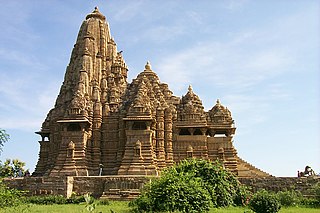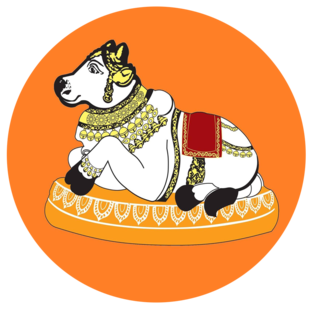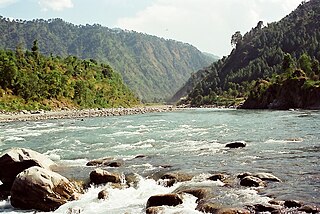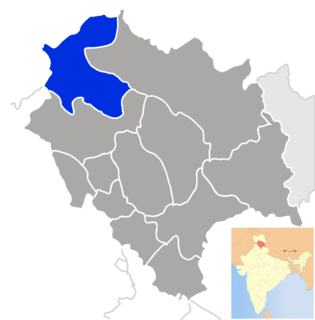
Chamba is the northwestern district of Himachal Pradesh, in India, with its headquarters in Chamba town. The towns of Dalhousie, Khajjhiar and Churah Valley are popular hill stations and vacation spots for the people from the plains of northern India. Chamba is the only district in northern India to preserve a well-documented history from c. 500 AD. Its high mountain ranges have given it a sheltered position and helped in preserving its centuries-old relics and numerous inscriptions. The temples erected by rajas of Chamba more than a thousand years ago continue to be under worship and the land grant-deeds executed on copper plates by them continue to be valid under the law.
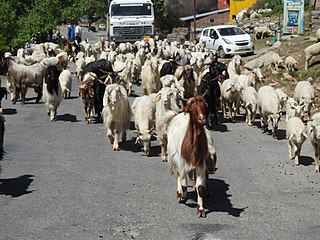
The Gaddis are a tribe living mainly in the Indian states of Himachal Pradesh and Jammu and Kashmir.

The Udayagiri Caves are twenty rock-cut caves near Vidisha, Madhya Pradesh from the early years of the 5th century CE. They contain some of the oldest surviving Hindu temples and iconography in India. They are the only site that can be verifiably associated with a Gupta period monarch from its inscriptions. One of India's most important archaeological sites, the Udayagiri hills and its caves are protected monuments managed by the Archaeological Survey of India.

Chamba is a town in the Chamba district in the Indian state of Himachal Pradesh. According to the 2001 Indian census, the town is situated on the banks of the Ravi River, at its confluence with the Sal River. Chambial were the Rulers of Chamba State Chambials use suffix Varmans.

Jageshwar Temples, also referred to as Jageswar Temples or Jageshwar valley temples, are a group of over 100 Hindu temples dated between 7th and 12th century near Almora, in the Himalayan Indian state of Uttarakhand. The valley has a number of temple clusters such as the Dandeshwar and Jageshwar sites. Some locations have attracted construction of new temples through the 20th-century. Together these clusters over the valley consist of over 200 structural temples built from cut stone. Many are small, while a few are substantial. They predominantly illustrate North Indian Nagara style of architecture with a few exceptions that show South and Central Indian style designs, many are dedicated to god Shiva, while others in immediate vicinity are dedicated to god Vishnu, Shakti goddesses and Surya traditions of Hinduism.

Eran is an ancient town and archaeological site in Sagar district of Madhya Pradesh, India. It was one of the ancient mints for Indian dynasties as evidenced by the diverse coins excavated here. The site has 5th and 6th-century Gupta era temples and monuments, particularly the colossal stone boar with sages and scholars depicted on the body of the sculpture. The inscription stones found at Eran are important to reconstructing the chronology and Gupta Empire history. Eran or Erakina was the capital of Erakina (Airikina) Pradesha or Airkina Vishaya, an administrative division of the Gupta empire.

The Dashavatara Temple is an early 6th century Vishnu Hindu temple located at Deogarh, Uttar Pradesh in the Betwa River valley in north-central India. It has a simple, one cell square plan and is one of the earliest Hindu stone temples still surviving today. Built in the Gupta Period, the Dashavatara Temple at Deogarh shows the ornate Gupta style architecture.

Chhatrari (Hindiछतरारी) is a village in India,inhabited by Gaddis, 48 km from Chamba. It is known for its Chhatrari Devi temple, which was built by King Meru Verman of Bharmour, in Chamba, Himachal Pradesh, at an altitude of 6000 feet above sea level. The main idol of this ancient 8th century temple is of Shakti, made of Ashtadhatu by a craftsman Gugga, 4 feet 6 inches tall which shows Shakti holding in her hands a lance, a lotus (life), a bell and a snake. There is also an inscription with details of the temple, the king and his ancestors, the craftsman, and the locales of the village. Every year on the third day of the Manimahesh Yatra to the Manimahesh Lake, water from Manimahesh Lake is brought, and the idol of Shakti is bathed in it, with pious rituals. Its history is closely woven with that of Bharmour, due to the Dharmeshvar Mahadev (Dharamraj) Temple in the northern corner of Chaurasi Temple Bharmour, also built by Raja Meru Verman.

Bateshwar Hindu temples are a group of nearly 200 sandstone Hindu temples and their ruins in north Madhya Pradesh in post-Gupta, early Gurjar-Pratihara style of North Indian temple architecture. It is about 35 kilometres (22 mi) north of Gwalior and about 30 kilometres (19 mi) east of Morena town. The temples are mostly small and spread over about 25 acres (10 ha) site. They are dedicated to Shiva, Vishnu and Shakti - representing the three major traditions within Hinduism. The site is within the Chambal River valley ravines, on the north-western slope of a hill near Padavali known for its major medieval era Vishnu temple. The Bateshwar temples were built between the 8th and the 10th-century. The site is likely named after the Bhuteshvar Temple, the largest Shiva temple at the site. It is also referred to as Batesvar temples site or Batesara temples site.
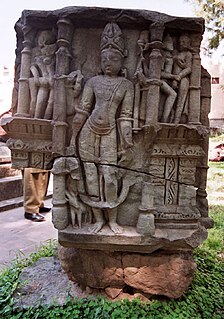
The Bhima Devi Temple Complex, nicknamed Khajuraho of North India for its erotic sculptures, comprises the restored ruins of an ancient Hindu temple dating from between 8th and 11th century AD, together with the adjacent 17th-century Pinjore gardens, located in Pinjore town in Panchkula district of the state of Haryana, India. Old temple was destroyed by the islmic invaders and the present 8-11th CE temple is likely built on the same place under the old name, and the nearby ancient baoli still has old Hindu pillars. Bhimadevi belongs to the Shakti tradition that was derived from the Buddhist tantric goddess. Further, in the Devi Mahatmya it is said that in the Western Himalayas of Himachal Pradesh, Bhimadevi appeared in an enormous form of Bhimarupa and gave protection to the sages.

Deogarh is a village in Lalitpur district of the Indian state of Uttar Pradesh. It is located on the right bank of Betwa River and to the west of Lalitpur hills. It is known for Gupta monuments and for many ancient monuments of Hindu and Jain origins inside and outside the walls of the fort.

The Manimahesh Kailash Peak, 5,653 metres (18,547 ft), also known as Chamba Kailash, which stands towering high over the Manimahesh Lake, is believed to be the abode of Lord Shiva, the. It is located in the Bharmour subdivision of the Chamba district in the Indian state of Himachal Pradesh. The peak is 26 kilometres (16 mi) from Bharmour in the Budhil valley. It is one of the major pilgrimage sites as well as a popular trekking destination in Himachal Pradesh. The Manimahesh Lake is at the base of the Kailash peak at 3,950 metres (12,960 ft) and is also held in deep veneration by people of Himachal Pradesh, particularly the Gaddi tribes of the region. In the month of Bhadon, on the eighth day of the new moon period a fair is held in the precincts of the lake that attracts thousands of pilgrims.
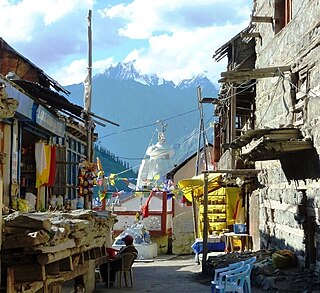
The Sri Trilokinath ji Temple is in a village of same name 6 km south of the left bank of the Chaṅdrābhāgā or Chenab River, and about 9 km from the village of Udaipur, in the Lahul and Spiti District of Himachal Pradesh, India. It is sacred to both Tibetan Buddhists and Hindus. The glittering white-painted temple is situated on a cliff at the end of a village street. Its altitude is 2,760 metres (9,055 ft).
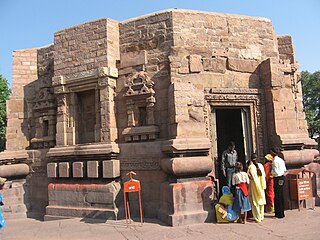
The Mundeshwari Devi Temple is located at Kaura in Kaimur district in the state of Bihar, India on the Mundeshwari Hills. It is an ancient temple dedicated to the worship of Lord Shiva and Shakti and is considered one of the oldest Hindu temples in India. It is also considered as the oldest functional Hindu temple of India. The information plaque erected by the Archaeological Survey of India (ASI) at the site indicates the dating of the temple to 625 CE. Hindu inscriptions dated 635 CE were found in the temple. The temple is a protected monument under ASI since 1915.
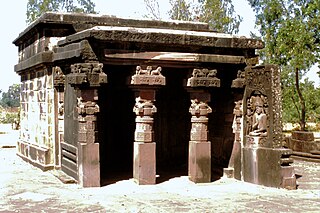
Tigawa is a village in Madhya Pradesh and an archaeological site with a complex of about 36 Hindu temple ruins. Of these, the ancient Kankali Devi Temple is in good condition, and is dated to about 400-425 CE. Also referred to as Tigowa or Tigwan, the site is about 4 kilometres (2.5 mi) north of Bahuriband between Katni and Jabalpur. The Hindu temple ruins were badly damaged during a colonial era railway project when a contractor demolished and excavated the ruins as building material for the railway project.

The Masrur Temples, also referred to as Masroor Temples or Rock-cut Temples at Masrur, is an early 8th-century complex of rock-cut Hindu temples in the Kangra Valley of Beas River in Himachal Pradesh, India. The temples face northeast, towards the Dhauladhar range of the Himalayas. They are a version of North Indian Nagara architecture style, dedicated to Shiva, Vishnu, Devi and Saura traditions of Hinduism, with its surviving iconography likely inspired by a henotheistic framework. Though a major temples complex in the surviving form, the archaeological studies suggest that the artists and architects had a far more ambititious plan and the complex remains incomplete. Much of the Masrur's temple's sculpture and reliefs have been lost. They were also quite damaged, most likely from earthquakes.

Teli ka Mandir, also known as Telika Temple, is a Hindu temple located within the Gwalior Fort in Madhya Pradesh, India. Dedicated to Vishnu, Shiva and Matrikas, it has been variously dated between the early 8th and early 9th century CE.

Nachna Hindu temples, also referred to as Nachana temples or Hindu temples at Nachna-Kuthara, are some of the earliest surviving stone temples in central India along with those at Bhumara and Deogarh. Their dating is uncertain, but comparing their style to structures that can be dated, some of the Nachna temples are variously dated to the 5th or 6th century Gupta Empire era. The Chaturmukha temple is dated to the 9th-century. These temples illustrate a North Indian style of Hindu temple architecture.
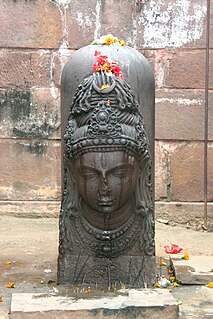
Bhumara Temple, sometimes called Bhumra, Bhubhara or Bharkuleswar, is a 5th or 6th-century Gupta era Hindu stone temple site dedicated to Shiva near Satna, in the Indian state Madhya Pradesh. The temple has a square plan with a sanctum and mandapa. While much of it is in ruins, enough of the temple structure and artwork has survived for scholarly studies. The temple is notable as one of the early examples of an architecture that included an enclosed concentric pradakshina-patha. Like other early Gupta era Hindu temples, it includes a decorated entrance to the sanctum flanked by Ganga and Yamuna goddesses, and intricately carved sculptures. The temple's Ekamukha Linga is a much studied example of Gupta art. The temple reliefs include those for Mahishasura-mardini (Durga), Ganesha, Brahma, Vishnu, Yama, Kubera, Kartikeya, Surya, Kama and others.

